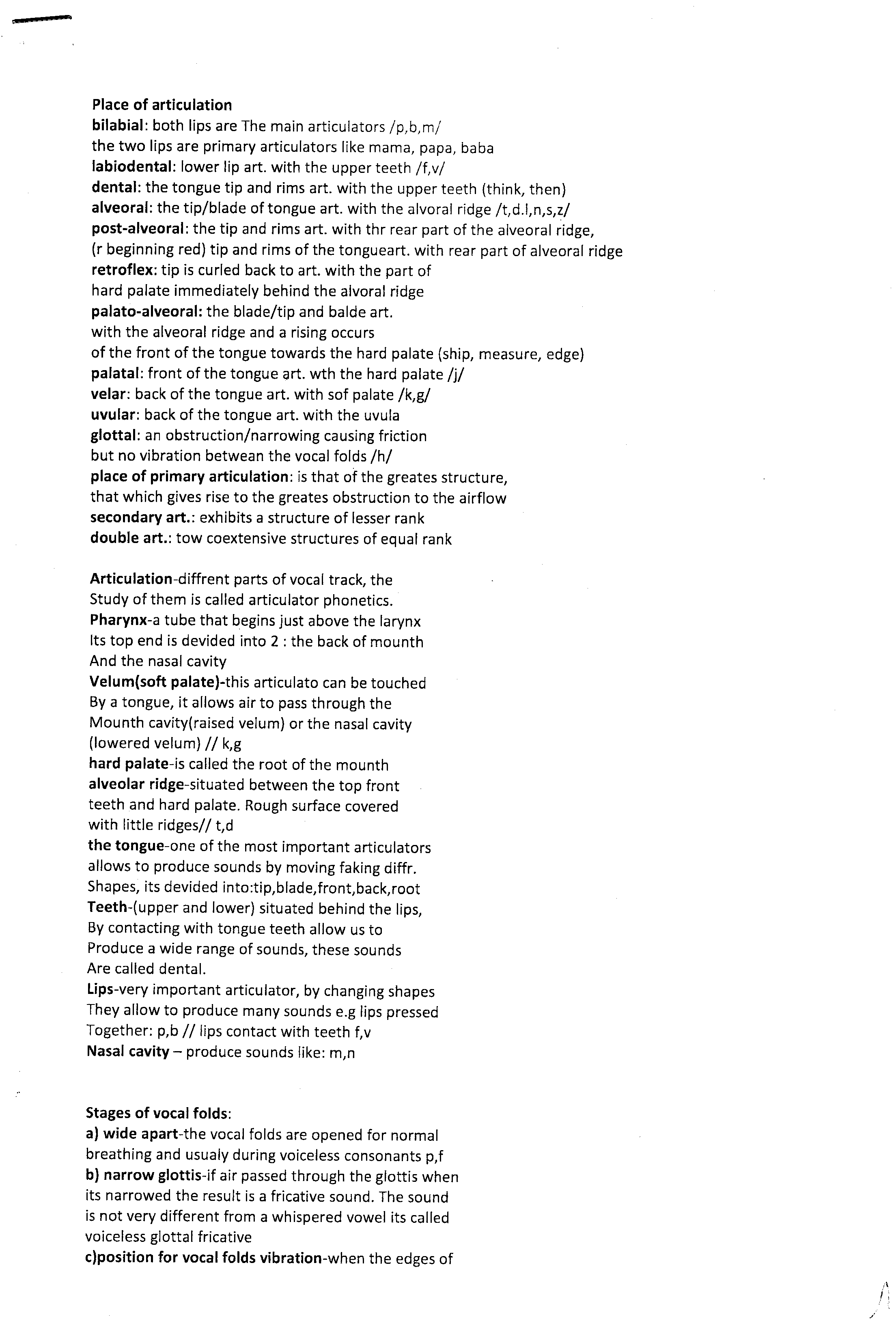skanuj0001

Place of articulation
bilabial: both lips are The main articulators /p,b,m/
the two lips are primary articulators like mama, papa, baba
labiodental: lower lip art. with the upper teeth /f,v/
dental: the tongue tip and rims art. with the upper teeth (think, then)
alveoral: the tip/blade of tongue art. with the alvoral ridge /t,d.l,n,s,z/
post-alveoral: the tip and rims art. with thr rear part of the alveoral ridge,
(r beginning red) tip and rims of the tongueart. with rear part of alveoral ridge
retroflex: tip is curled back to art. with the part of
hard palate immediately behind the alvoral ridge
palato-alveoral: the blade/tip and balde art.
with the alveoral ridge and a rising occurs
of the front of the tongue towards the hard palate (ship, measure, edge)
palatal: front of the tongue art. wth the hard palate /]/
velar: back of the tongue art. with sof palate /k,g/
uvular: back of the tongue art. with the uvula
glottal: an obstruction/narrowing causing friction
but no vibration betwean the vocal folds /h/
place of primary articulation: is that of the greates structure,
that which gives rise to the greates obstruction to the airflow
secondary art.: exhibits a structure of lesser rank
double art.: tow coextensive structures of equal rank
Articulation-diffrent parts of vocal track, the Study of them is called articulator phonetics.
Pharynx-a tubę that begins just above the larynx Its top end is devided into 2 : the back of mounth And the nasal cavity
Velum(soft palate)-this articulato can be touched By a tongue, it allows air to pass through the Mounth cavity(raised velum) or the nasal cavity (lowered velum) // k,g hard palate-is called the root of the mounth alveolar ridge-situated between the top front teeth and hard palate. Rough surface covered with little ridges// t,d
the tongue-one ofthe most important articulators allows to produce sounds by moving faking diffr.
Shapes, its devided into:tip,blade,front,back,root Teeth-(upper and lower) situated behind the lips,
By contacting with tongue teeth allow us to Produce a wide rangę of sounds, these sounds Are called dental.
Lips-very important articulator, by changing shapes They allow to produce many sounds e.g lips pressed Together: p,b // lips contact with teeth f,v Nasal cavity- produce sounds like: m,n
Stages of vocal folds:
a) wide apart-the vocal folds are opened for normal breathing and usualy during voiceless consonants p,f
b) narrow glottis-if air passed through the glottis when its narrowed the result is a fricative sound. The sound is not very different from a whispered vowel its called voiceless glottal fricative
c) position for vocal folds vibration-when the edges of
Wyszukiwarka
Podobne podstrony:
can bc generalized to another place of articulation. Results to be pre-sented are of tongue movemcnt
c Page String of Flowers -I& II Both projects are designedfor TWO Shuttles © 2007, Nina Libin T
1. INTRODUCTION The results of various accident scenario simulations for the two major MHTGR variant
Picture 4 Changing Lower Body Parts Transportation devices can be attached in place of the lower bod
Speakers of Spoon River • The speakers are inhabitants (both real are imagined) of
18 Mikroekonomia BANK I KREDYT styczeń 2008 that at tliis level of earuings both partuers are taxed
CCF20110611�052 A tongue slip „law”. „the target and the origin of a tongue-slip are both located In
DSCI3117 342. Which places of articulation are defined below? a) the lower lip art
Upstream from the weir, up to thc uppcr end of the river section utilized, both banks are raised and
246 (21) The dermatological examination is concemed with whether one or both feet are affected, the
więcej podobnych podstron